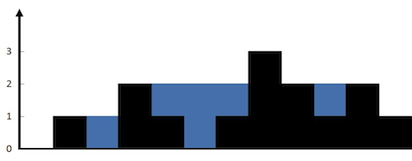11.Container With Most Water
Given n non-negative integers a1, a2, ..., an, where each represents a point at coordinate (i, ai). n vertical lines are drawn such that the two endpoints of line i is at (i, ai) and (i, 0). Find two lines, which together with x-axis forms a container, such that the container contains the most water.
Note: You may not slant the container.
S: two pinter, recursion O(n)
对于由ai,aj(i<j)组成的container Area(ai,aj)其容积是由较短的板决定的。若ai<aj,都有MaxArea(ai,aj)=max(Area(ai,aj), MaxArea(ai+1,aj)).
int maxArea(vector<int>& height) {
return findMax(height, 0, height.size()-1);
}
int findMax(vector<int>& height, int left, int right){
if(left == right) return 0;
int currentArea = (right - left) * min(height[left], height[right]);
if(height[left] <= height[right]) {
return max(findMax(height, left+1, right), currentArea);
}
else return max(findMax(height, left, right-1), currentArea);
}
iteration version:
int maxArea(vector<int>& height) {
int max = 0;
int l = 0, r = height.size() - 1;
while(l < r){
int currentArea = (r - l) * min(height[l], height[r]);
if(currentArea > max) max = currentArea;
if(height[l] <= height[r]) l++;
else r--;
}
return max;
}
42. Trapping Rain Water
Given n non-negative integers representing an elevation map where the width of each bar is 1, compute how much water it is able to trap after raining.
For example,
Given [0,1,0,2,1,0,1,3,2,1,2,1], return 6.
The above elevation map is represented by array [0,1,0,2,1,0,1,3,2,1,2,1]. In this case, 6 units of rain water (blue section) are being trapped. Thanks Marcos for contributing this image!
S: two pointer O(n)time O(1)space.
建模:两边到中间,水的加和减
int trapRainWater(vector<int> &heights) {
int water = 0, bar = 0;
int l = 0, r = heights.size()-1;
while(l < r){
int newBar = min(heights[l], heights[r]);
if(newBar <= bar) {
water -= newBar;
} else{
water += (r - l - 1) * (newBar - bar)- bar;
bar = newBar;
}
if(heights[l] > heights[r]) {
r--;
} else {
l++;
}
}
return water;
}
407. Trapping Rain Water II
Given anm x nmatrix of positive integers representing the height of each unit cell in a 2D elevation map, compute the volume of water it is able to trap after raining.
Note:
Both m and n are less than 110. The height of each unit cell is greater than 0 and is less than 20,000.
Example:
Given the following 3x6 height map:
[
[1,4,3,1,3,2],
[3,2,1,3,2,4],
[2,3,3,2,3,1]
]
Return 4.
S:heap O(mnlogmn)
- 找外围,存入minheap
- 从瓶颈点向内找最小,并更新heap
更新heap: 每次pop当前瓶颈节点并存入內围节点坐标,若內围节点height高于当前瓶颈高度,存入內围节点高度,否则在新节点仍然存入当前瓶颈高度
struct Node {
int x;
int y;
int height;
Node(int i, int j, int h): x(i), y(j), height(h) {}
};
struct cmp {
bool operator() (const Node* a, const Node* b) const{
return a->height > b->height;
}
};
class Solution {
public:
int trapRainWater(vector<vector<int>>& heightMap) {
int m = heightMap.size();
if (m < 3) {
return 0;
}
int n = heightMap[0].size();
if (n < 3) {
return 0;
}
vector<vector<bool>> visited(m, vector<bool>(n, false));
priority_queue<Node*, vector<Node*>, cmp> minHeap;
int result = 0;
for (int i = 0; i < m; ++i) {
Node* node1 = new Node(i, 0, heightMap[i][0]);
minHeap.push(node1);
Node* node2 = new Node(i, n - 1, heightMap[i][n - 1]);
minHeap.push(node2);
visited[i][0] = true;
visited[i][n - 1] = true;
}
for (int i = 1; i < n - 1; ++i) {
Node* node1 = new Node(0, i, heightMap[0][i]);
minHeap.push(node1);
Node* node2 = new Node(m - 1, i, heightMap[m - 1][i]);
minHeap.push(node2);
visited[0][i] = true;
visited[m - 1][i] = true;
}
vector<int> dx{0, 1, 0, -1};
vector<int> dy{1, 0, -1, 0};
while (!minHeap.empty()) {
Node* cur = minHeap.top();
minHeap.pop();
for(int k = 0; k < 4; ++k) {
int x = cur->x + dx[k];
int y = cur->y + dy[k];
if (x > 0 && x < m && y >0 && y < n &&
!visited[x][y]) {
int h = heightMap[x][y];
result += max(0, cur->height - h);
h = max(h, cur->height); //keep the original height if current height is lower
Node* node = new Node(x, y, h);
minHeap.push(node);
visited[x][y] = true;
}
}
}
return result;
}
};